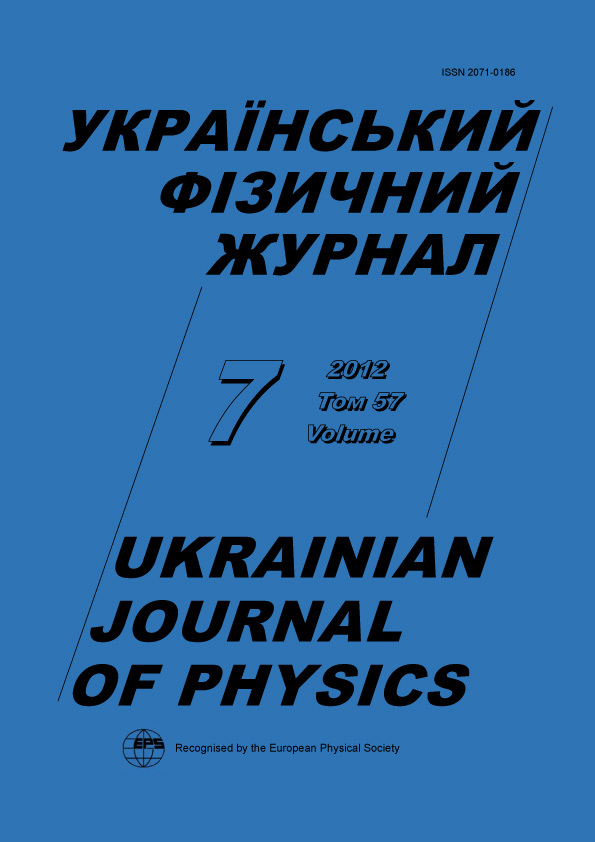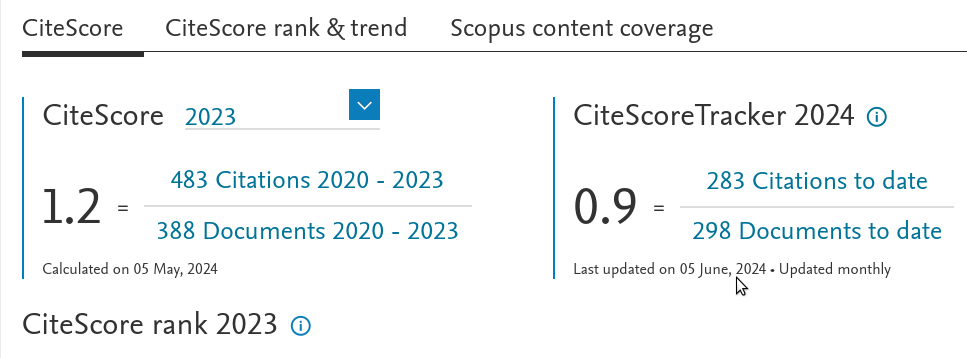Glucose Oxidase Immobilization onto Carbon Nanotube Networking
DOI:
https://doi.org/10.15407/ujpe57.7.700Keywords:
-Abstract
When elaborating the biosensor based on single-walled carbon nanotubes (SWNTs), it is necessary to solve such an important problem as the immobilization of a target biomolecule on the nanotube surface. In this work, the enzyme (glucose oxidase (GOX)) was immobilized on the surface of a nanotube network, which was created by the deposition of nanotubes from their solution in 1,2-dichlorobenzene by the spray method. 1-Pyrenebutanoic acid succinimide ester (PSE) was used to form the molecular interface, the bifunctional molecule of which provides the covalent binding with the enzyme shell, and its other part (pyrene) is adsorbed onto the nanotube surface. First, the usage of such a molecular interface leaves out the direct adsorption of the enzyme (in this case, its activity decreases) onto the nanotube surface, and, second, it ensures the enzyme localization near the nanotube. The comparison of the resonance Raman (RR) spectrum of pristine nanotubes with their spectrum in the PSE environment evidences the creation of a nanohybrid formed by an SWNT with a PSE molecule which provides the further enzyme immobilization. As the RR spectrum of an SWNT:PSE:GOX film does not essentially differ from that of SWNT:PSE ones, this indicates that the molecular interface (PSE) isolates the enzyme from nanotubes strongly enough. The efficient immobilization of GOX along the carbon nanotubes due to PSE is confirmed with atom-force microscopy images. The method of molecular dynamics allowed us to establish the structures of SWNT:PSE:GOX created in the aqueous environment and to determine the interaction energy between hybrid
components. In addition, the conductivity of the SWNT network with adsorbed PSE and GOX molecules is studied. The adsorption of PSE molecules onto the SWNT network causes a decrease of the conductivity, which can be explained by the appearance of scattering centers for charge carriers on the nanotube surface, which are created by PSE molecules.
References
K. Balasubramanian and M. Burghard, Anal. Bioanal. Chem. 385, 452 (2006).
https://doi.org/10.1007/s00216-006-0314-8
G. Gruner, Anal. Bioanal. Chem. 384, 322 (2006).
https://doi.org/10.1007/s00216-005-3400-4
S. Roy and Z. Gao, Nano Today 4, 318 (2009).
https://doi.org/10.1016/j.nantod.2009.06.003
K. Besteman, J.O. Lee, F.G. Wiertz, H.A. Heering, and C. Dekker, Nano Lett. 3, 727 (2003).
https://doi.org/10.1021/nl034139u
X. Dong, C.M. Lau, A. Lohani, S.G. Mhaisalkar, J. Kasim, Z. Shen, X. Ho, J.A. Rogers, and L-J. Li, Adv. Mater. 20, 2389 (2008).
https://doi.org/10.1002/adma.200702798
P.W. Barone, S. Baik, D.A. Heller, and M.S. Strano, Nature Mater. 4, 86 (2005).
https://doi.org/10.1038/nmat1276
S.S. Karajanagi, A.A. Vertegel, R.S. Kane, and J.S. Dordick, Langmuir 20, 11594 (2004).
https://doi.org/10.1021/la047994h
R.J. Chen, Y. Zhang, D. Wang, and H. Dai, J. Am. Chem. Soc. 123, 3838 (2001).
https://doi.org/10.1021/ja010172b
S.G. Stepanian, V.A. Karachevtsev, A.Yu. Glamazda, U. Dettlaff-Weglikowska, and L. Adamowicz, Mol. Phys. 101, 2609 (2003).
https://doi.org/10.1080/0026897031000154284
W.E. Alvarez, F. Pompeo, J.E. Herrera, L. Balzano, and D.E. Resasco, Chem. Mater. 14, 1853 (2002).
https://doi.org/10.1021/cm011613t
C.P. James, B. Rosemary, W. Wang, J. Gumbart, E. Tajkhorshid, E. Villa, C. Chipot, R.D. Skeel, L. Kale, and K. Schulten, J. Comput. Chem. 26, 1781 (2005).
https://doi.org/10.1002/jcc.20289
A.D. MacKerell jr., D. Bashford, M. Bellott, R.L. Dunbrack jr., J.D. Evanseck, M.J. Field, S. Fischer, J. Gao, H. Guo, S. Ha, D. Joseph-McCarthy, L. Kuchnir, K. Kuczera, F.T.K. Lau, C. Mattos, S. Michnick, T. Ngo, D.T. Nguyen, B. Prodhom, W.E. Reiher, B. Roux, M. Schlenkrich, J.C. Smith, R. Stote, J. Straub, M. Watanabe, J.
Wiorkiewicz-Kuczera, D. Yin, and M. Karplus, J. Phys. Chem. B 102, 3586 (1998).
https://doi.org/10.1021/jp973084f
G. Wohlfahrt, S. Witt, J. Hendle, D. Schomburg, H.M. Kalisz, and H.-J. Hecht, Acta Cryst. D 55, 969 (1999).
https://doi.org/10.1107/S0907444999003431
V.A. Karachevtsev, S.G. Stepanian, A.Yu. Glamazda, M.V. Karachevtsev, V.V. Eremenko, O.S. Lytvyn, and L. Adamowicz, J. Phys. Chem. C 115, 21072 (2011).
https://doi.org/10.1021/jp207916d
W. Humphrey, A. Dalke, and K. Schulten, J. Molec. Graphics 14, 33 (1996).
https://doi.org/10.1016/0263-7855(96)00018-5
S.G. Stepanian, M.V. Karachevtsev, A.Yu. Glamazda, V.A. Karachevtsev, and L. Adamowicz, J. Phys. Chem. A 113, 3621 (2009).
https://doi.org/10.1021/jp810205a
C. Fantini, A. Jorio, A.P. Santos, V.S.T. Peressinotto, and M.A. Pimenta, Chem. Phys. Lett. 439, 138 (2007).
https://doi.org/10.1016/j.cplett.2007.03.085
S.K. Doorn, J. Nanosci. Nanotech. 5, 1023 (2005).
https://doi.org/10.1166/jnn.2005.170
S.G. Chou, H.B. Ribeiro, E.B. Barros, A.P. Santos, D. Nezich, Ge.G. Samsonidze, C. Fantini, M.A. Pimenta, A. Jorio, F. Plentz Filho, M.S. Dresselhaus, G. Dresselhaus, R. Saito, M. Zheng, G.B. Onoa, E.D. Semke, A.K. Swan, M.S. Ünlü, and B.B. Goldberg, Chem. Phys. Lett. 397, 296 (2004).
https://doi.org/10.1016/j.cplett.2004.08.117
M.S. Dresselhaus and P.C. Eklund, Adv. Phys. 49, 705 (2000).
https://doi.org/10.1080/000187300413184
A.M. Rao, P.C. Eklund, S. Bandow, A. Thess, and R.E. Smalley, Nature 388, 257 (1997).
S. Heinze, J. Tersoff, R. Martel, V. Derycke, J. Appenzeller, and P. Avouris, Phys. Rev. Lett. 89, 106801 (2002). https://doi.org/10.1103/PhysRevLett.89.106801
W. Kim, A. Javey, O. Vermesh, Q. Wang, and H. Dai, Nano Lett. 3, 193 (2003). https://doi.org/10.1021/nl0259232
Downloads
Published
How to Cite
Issue
Section
License
Copyright Agreement
License to Publish the Paper
Kyiv, Ukraine
The corresponding author and the co-authors (hereon referred to as the Author(s)) of the paper being submitted to the Ukrainian Journal of Physics (hereon referred to as the Paper) from one side and the Bogolyubov Institute for Theoretical Physics, National Academy of Sciences of Ukraine, represented by its Director (hereon referred to as the Publisher) from the other side have come to the following Agreement:
1. Subject of the Agreement.
The Author(s) grant(s) the Publisher the free non-exclusive right to use the Paper (of scientific, technical, or any other content) according to the terms and conditions defined by this Agreement.
2. The ways of using the Paper.
2.1. The Author(s) grant(s) the Publisher the right to use the Paper as follows.
2.1.1. To publish the Paper in the Ukrainian Journal of Physics (hereon referred to as the Journal) in original language and translated into English (the copy of the Paper approved by the Author(s) and the Publisher and accepted for publication is a constitutive part of this License Agreement).
2.1.2. To edit, adapt, and correct the Paper by approval of the Author(s).
2.1.3. To translate the Paper in the case when the Paper is written in a language different from that adopted in the Journal.
2.2. If the Author(s) has(ve) an intent to use the Paper in any other way, e.g., to publish the translated version of the Paper (except for the case defined by Section 2.1.3 of this Agreement), to post the full Paper or any its part on the web, to publish the Paper in any other editions, to include the Paper or any its part in other collections, anthologies, encyclopaedias, etc., the Author(s) should get a written permission from the Publisher.
3. License territory.
The Author(s) grant(s) the Publisher the right to use the Paper as regulated by sections 2.1.1–2.1.3 of this Agreement on the territory of Ukraine and to distribute the Paper as indispensable part of the Journal on the territory of Ukraine and other countries by means of subscription, sales, and free transfer to a third party.
4. Duration.
4.1. This Agreement is valid starting from the date of signature and acts for the entire period of the existence of the Journal.
5. Loyalty.
5.1. The Author(s) warrant(s) the Publisher that:
– he/she is the true author (co-author) of the Paper;
– copyright on the Paper was not transferred to any other party;
– the Paper has never been published before and will not be published in any other media before it is published by the Publisher (see also section 2.2);
– the Author(s) do(es) not violate any intellectual property right of other parties. If the Paper includes some materials of other parties, except for citations whose length is regulated by the scientific, informational, or critical character of the Paper, the use of such materials is in compliance with the regulations of the international law and the law of Ukraine.
6. Requisites and signatures of the Parties.
Publisher: Bogolyubov Institute for Theoretical Physics, National Academy of Sciences of Ukraine.
Address: Ukraine, Kyiv, Metrolohichna Str. 14-b.
Author: Electronic signature on behalf and with endorsement of all co-authors.













